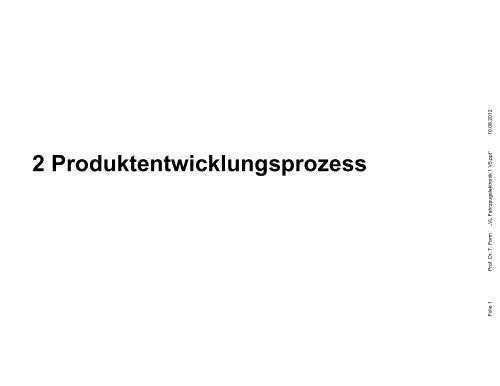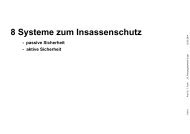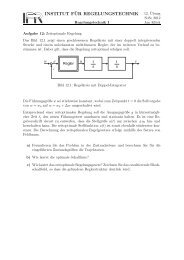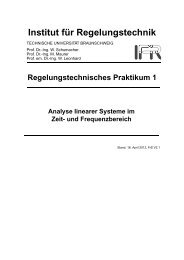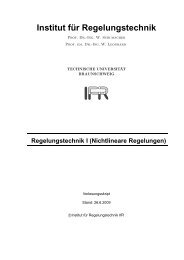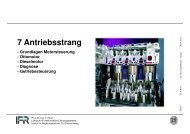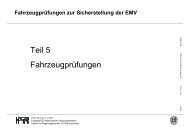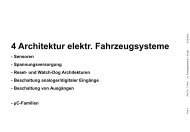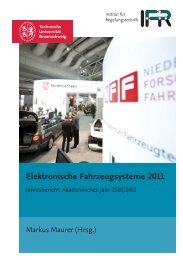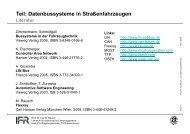Teil 2
Teil 2
Teil 2
You also want an ePaper? Increase the reach of your titles
YUMPU automatically turns print PDFs into web optimized ePapers that Google loves.
2 Produktentwicklungsprozess<br />
Folie 1 Prof. Dr. T. Form „VL Fahrzeugelektronik 1 V5.ppt“ 10.08.2012
Produktprozesse bei einem Automobilhersteller<br />
Geschäftsprozesse<br />
Steuerungs- und<br />
Produktprozess<br />
Kundenauftragsprozess<br />
Serviceprozesse vor Kunde<br />
unterstützende Prozesse<br />
Quelle: VW AG<br />
Folie 2 Prof. Dr. T. Form „VL Fahrzeugelektronik 1 V5.ppt“ 10.08.2012
Produktentstehungsprozess (PEP)<br />
Phasen<br />
PPS<br />
Projekt-<br />
Planungs-<br />
Start<br />
Forschungsprojekte/-ergebnisse (&Vorentwicklung)<br />
Forschungsergebnisse<br />
Konzeptentwicklung<br />
SP<br />
Strateg.-<br />
Projektbeginn<br />
PD<br />
Projekt-<br />
Definition<br />
PE<br />
Projektentscheid<br />
• Der PEP ist ein Referenzprozess<br />
Serienentwicklung<br />
V1PT<br />
Virtueller<br />
1. Prototyp<br />
LF<br />
Launch-<br />
Freigabe<br />
Serienvorbereitung<br />
• Inhalte und Reihenfolge der Meilensteine sind fest<br />
• Basiszeiten dienen zur Orientierung bei der Projektplanung, werden aber<br />
projektspezifisch angepasst<br />
• Abweichungen benötigen Sondermaßnahmen<br />
SOP ME<br />
Serienanlauf<br />
Start Of<br />
Production<br />
Serienbetreuung<br />
Markt-<br />
Einführung<br />
Quelle: VW AG, K-DOG<br />
Folie 3 Prof. Dr. T. Form „VL Fahrzeugelektronik 1 V5.ppt“ 10.08.2012
Produktprozesse bei einem Automobilhersteller<br />
Produktentstehungsprozess<br />
Produktenstehungsprozess (PEP)<br />
Quelle: VW AG<br />
Folie 4 Prof. Dr. T. Form „VL Fahrzeugelektronik 1 V5.ppt“ 10.08.2012
Produktprozesse bei einem Automobilhersteller<br />
Produktentstehungsprozess<br />
PPS<br />
POS<br />
Konzeptentwicklung Serienentwicklung<br />
Serienvorbereitung<br />
SBP<br />
SP<br />
Produktplanung<br />
Package, Konzepte<br />
PD<br />
Produktions-, Logistikkonzepte<br />
PE<br />
DE/LH1<br />
Design Exterieur, Interieur / Technikbegleitung<br />
Strak<br />
V1PT<br />
DDKM<br />
Datenkontrollmodell<br />
DKM/LH2<br />
Konstruktion, Berechnung, Steuergeräte<br />
Versuchsträgerbau<br />
Erprobung<br />
Konzeptwettbewerb Produktionsvorbereitung, Werkzeuge, Logistik<br />
LF<br />
Prioritätsgestaffelte Freigaben, BMG<br />
PVS 0S SOP ME<br />
Typprüfung<br />
Forward Sourcing Vorserie<br />
Marketing, Vertrieb, Kundendienst<br />
Projektplanung, -verfolgung, -steuerung<br />
Umwelt<br />
Qualitätssicherung, -maßnahmen<br />
Program Readiness<br />
(Pre-) Launch<br />
Serienbetreuung<br />
Serie<br />
Quelle: VW AG, K-DOG<br />
Folie 5 Prof. Dr. T. Form „VL Fahrzeugelektronik 1 V5.ppt“ 10.08.2012
Produktentstehungsprozess (PEP)<br />
Konzeptentwicklung – Skizzen Außenstudien Modell<br />
Konzeptentwicklung Designgeschichte<br />
PPS POS SBP SP PD PE<br />
Produktplanung<br />
Projektplanung, -verfolgung, -steuerung<br />
Package, Konzepte<br />
Design Exterieur, Interieur / Technikbegleitung<br />
Strak<br />
Säulendesign<br />
Konstruktion, Berechnung, Steuergeräte<br />
Versuchsträgerplanung, Versuchsträgerbau<br />
Produktions-, Logistikkonzepte<br />
Konzeptwettbewerb Produktionsvorbereitung, Werkzeuge, Anlagen, Logistik<br />
Forward Sourcing<br />
Marketing, Vertrieb, Kundendienst<br />
Umwelt<br />
Qualitätssicherung, -maßnahmen<br />
Claymodell<br />
Quelle: VW AG, K-DOG<br />
Folie 6 Prof. Dr. T. Form „VL Fahrzeugelektronik 1 V5.ppt“ 10.08.2012
Produktentstehungsprozess (PEP)<br />
Serienentwicklung - Designentscheidung<br />
PE<br />
DE/LH1<br />
Serienentwicklung<br />
V1PT DDKM<br />
Projektplanung, -verfolgung, -steuerung<br />
DKM/LH2<br />
Design Exterieur, Interieur / Technikbegleitung<br />
Strak<br />
Datenkontrollmodell<br />
Konstruktion, Berechnung, Steuergeräte<br />
Versuchsträgerplanung, Versuchsträgerbau<br />
Erprobung und Vergleichsfahrten<br />
Prioritätsgestaffelte Freigaben, BMG<br />
Produktionsvorbereitung, Werkzeuge, Anlagen, Logistik<br />
Forward Sourcing<br />
Program Readiness<br />
Marketing, Vertrieb, Kundendienst<br />
Umwelt<br />
Qualitätssicherung, -maßnahmen<br />
LF<br />
Quelle: VW AG, K-DOG<br />
Folie 7 Prof. Dr. T. Form „VL Fahrzeugelektronik 1 V5.ppt“ 10.08.2012
Produktentstehungsprozess (PEP)<br />
Einbau von Komponenten: Schnitt durch Instrumententafel<br />
Heizgerät<br />
Frontscheibenanströmer<br />
Modulträger<br />
Ausströmer<br />
Navigation<br />
Folie 8 Prof. Dr. T. Form „VL Fahrzeugelektronik 1 V5.ppt“ 10.08.2012
Produktentstehungsprozess (PEP)<br />
Simulation und Berechnung<br />
SP PE DE/LH1 V1.PT DDKM DKM/LH2 PVS 0-S SOP<br />
PD<br />
DigitalesMockUp<br />
PR1 PR2<br />
P-Freigabe<br />
B-Freigabe<br />
CAD Konstruktion<br />
Berechnung/ Simulation<br />
Folie 9 Prof. Dr. T. Form „VL Fahrzeugelektronik 1 V5.ppt“ 10.08.2012
Produktentstehungsprozess (PEP)<br />
CAD Modell<br />
VW BORA<br />
Folie 10 Prof. Dr. T. Form „VL Fahrzeugelektronik 1 V5.ppt“ 10.08.2012
Produktentstehungsprozess (PEP)<br />
Digital Mockup Reifegrade am Beispiel Waschwasserbehälter<br />
Im Digital Mockup (€U) des Fahrzeuges werden Datenmodelle aller Bauteile in einem CAD-System in ihrer<br />
vorgesehenen Einbauposition zusammengespielt, um zu untersuchen:<br />
• Kollisionen/Überschneidungen<br />
• Montierbarkeit<br />
• Einhaltung von Mindestabständen, z.B. zu bewegten <strong>Teil</strong>en.<br />
Das Bauteilmodell muss die Oberfläche des Bauteils möglichst gut nachbilden, innere Details sind hier<br />
irrelevant und sollten zur Reduzierung des Datenvolumens nicht nachgebildet werden. Mit dem<br />
Entwicklungsfortschritt reift das Datenmodell, gerade für die Konzeptbestimmenden Bauraumuntersuchungen<br />
sind sehr früh Modelle erforderlich, die dann bei Neuteilen nur grob deren Außenflächen darstellen (s. Beispiel)<br />
Platzhalter<br />
Package-Dummy<br />
Konzeptmodell Seriennahes Modell<br />
Folie 11 Prof. Dr. T. Form „VL Fahrzeugelektronik 1 V5.ppt“ 10.08.2012
Produktentstehungsprozess (PEP)<br />
Finite Elemente Modell (FEM) als Berechnungsgrundlage<br />
für Festigkeit (Dauerhaltbarkeit), Steifigkeit (Geräusche, Fahrverhalten) und Crashverhalten<br />
Folie 12 Prof. Dr. T. Form „VL Fahrzeugelektronik 1 V5.ppt“ 10.08.2012
Produktentstehungsprozess (PEP)<br />
Simulation Kopfaufschlag<br />
Folie 13 Prof. Dr. T. Form „VL Fahrzeugelektronik 1 V5.ppt“ 10.08.2012
Produktentstehungsprozess (PEP)<br />
Crashtests zur Validierung der konstruktiven Auslegung und Berechnung<br />
Folie 14 Prof. Dr. T. Form „VL Fahrzeugelektronik 1 V5.ppt“ 10.08.2012
Produktentstehungsprozess (PEP)<br />
Serienvorbereitung - Cubing und Meisterbock<br />
LF<br />
Serienenvorbereitung<br />
PVS 0S SOP ME<br />
Projektplanung, -verfolgung, -steuerung<br />
Konstruktion, Berechnung, Steuergeräte<br />
Versuchsträgerplanung, Versuchsträgerbau<br />
Erprobung und Vergleichsfahrten<br />
Typprüfung<br />
Prioritätsgestaffelte Freigaben, BMG<br />
Produktionsvorbereitung, Werkzeuge, Anlagen, Logistik<br />
Vorserie Serie<br />
Program Readiness<br />
M, V, Kd<br />
(Pre-) Launch<br />
Umwelt<br />
Qualitätssicherung, -maßnahmen<br />
Meisterbock<br />
Der Meisterbock wird aus<br />
miteinander verschraubbaren<br />
Alustrangprofilen montiert. Er<br />
gibt gleichbleibende Referenz-<br />
punkte im Fahrzeuglebenslauf<br />
vor. Diese Referenzpunkte<br />
werden in der Konstruktionszeichnung<br />
definiert. An ihnen<br />
richten sich im Fahrzeugbau alle<br />
Zusammenbauten des<br />
Gesamtfahrzeugs aus.<br />
Cubing<br />
Cubing ist das Prüfen von Originalteilen<br />
in einer Nennmaßumgebung<br />
(Referenzflächen). Dazu können sie in<br />
eine im Maßstab 1:1 aus Aluminium<br />
gefräste Replik des Zielfahrzeugs<br />
eingesetzt werden. An diesem Modell<br />
wird dann die Passform des zu<br />
produzierenden <strong>Teil</strong>s geprüft und<br />
gegebenenfalls optimiert<br />
Quelle: VW AG, K-DOG<br />
Folie 15 Prof. Dr. T. Form „VL Fahrzeugelektronik 1 V5.ppt“ 10.08.2012
Produktentstehungsprozess (PEP)<br />
Phasen<br />
Folie 16 Prof. Dr. T. Form „VL Fahrzeugelektronik 1 V5.ppt“ 10.08.2012
Markterfolg<br />
Wettbewerbsbestimmende Faktoren<br />
Erfolgsfaktoren<br />
Produktivität<br />
Schwerpunkte ...<br />
der 60er/ 70er Jahre<br />
Qualität<br />
1960 1970 1980 1990 2000<br />
der 80er/ 90er Jahre<br />
Im Jahr 2000<br />
Kosten<br />
Qualität<br />
Zeit<br />
Lohnkostenvorteil<br />
Prozeßkosten<br />
Entwicklungszeit<br />
für Innovationen<br />
niedrige Kosten plus<br />
Leistungsdifferenzierung<br />
Kosten, Qualität,Schnelligkeit,<br />
Flexibilität<br />
Folie 17 Prof. Dr. T. Form „VL Fahrzeugelektronik 1 V5.ppt“ 10.08.2012
Markterfolg<br />
Bedeutung des Faktors Zeit<br />
Markt-,<br />
Umsatzvolumen<br />
„Pionier“<br />
... bei langen Produktzyklen<br />
„Follower“<br />
„Markt des<br />
Followers“<br />
Zeit<br />
Zahlen aus der Computerindustrie:<br />
Erhöhung der<br />
Entwicklungskosten<br />
um 50%<br />
-4%<br />
Einbuße im Ergebnis<br />
Erhöhung der<br />
Produktionskosten<br />
um 10%<br />
- 22%<br />
Markt-,<br />
Umsatzvolumen<br />
„Pionier“<br />
Verlängerung der<br />
Entwicklungszeit<br />
um 6 Monate<br />
- 33%<br />
... bei kurzen Produktzyklen<br />
„Follower“<br />
„Markt des<br />
Followers“<br />
Zeit<br />
Die Entwicklungszeit hat<br />
den größten Einfluß auf<br />
das Ergebnis.<br />
Quelle: Siemens Chip Entwicklung<br />
Folie 18 Prof. Dr. T. Form „VL Fahrzeugelektronik 1 V5.ppt“ 10.08.2012
Kostenbildung<br />
Arbeitsstückliste<br />
Umf 1 2 3 4 5 6 7 Benennung COP<br />
Lieferumfang vormontierter Zsb. Instrumententafel<br />
PR-Nr.<br />
Gew. err.<br />
Gew. gew.<br />
Menge<br />
Summe<br />
W erkstoff Oberfläche Lieferant<br />
I I I-- 1J1 857 001J Z INSTRUMENTENTAFEL vollst. 4Y siehe Einzelteile HF Z 1J A 850 V<br />
I I I I-- 1J1 857 003E Z INSTRUMENTENTAFEL 5Y 8111 1 8111 siehe Einzelteile HF Z 1J A 850 V<br />
I I I I I-- 1J1 858 295E GRUNDKOERPER 5 3000 1 PPE+PS TL 52 013 Ausf.A HF Z 1J A 850 V<br />
I I I I I-- 1J1 857 009B Z INSTRUMENTENTAFEL obert. gestanzt 6Y siehe Einzelteile HF Z 1J A 528 V<br />
I I I I I I-- 1J1 857 181A FOLIE slush-haut 6 1300 1 PVC-Pulver Narbung Fa.Magna+HF Z 1J A 844 V<br />
I I I I I I-- 1J0 857 177B SCHAUMTEIL 6 1520 1 PUR-SCHAUM HF Z 1J A 608 V<br />
I I I I I I-- 1J1 857 255 VERSTAERKUNG ausströmer fs 6 43 ST 37 2K W alzdraht Güte 09 Fa. Löttco Z 1J A 608 V<br />
I I I I I I-- 1J1 857 256 VERSTAERKUNG ausströmer bfs 6 44 ST 37 2K W alzdraht Güte 09 Fa. Löttco Z 1J A 608 V<br />
I I I I I I-- 1J0 857 268 VERSTAERKUNG ausströmer mitte 6 74 1 ST 37 2K W alzdraht Güte 09 Fa. Löttco Z 1J A 608 V<br />
I I I I I I-- 1J1 857 091B TRAEGER INSTR.TAFEL obert. 6 2080 1 PPE+PS-GF10 TL 52 013 Ausf.B HF Z 1J A 398 V<br />
I I I I I-- 1J1 857 473A LUFTVERTEILER mitte frontscheibe 5 50 1 PPE+PS-GF10 TL 52 013 Ausf.B Narbung, Decklack HF Z 1J A 408 V<br />
Montage diverser Schnappmuttern<br />
Kleben diverser Filzstreifen<br />
I I I I-- 1J1 880 216B Z HALTERAHMEN airbag bfs 4 345 1 345 St14 Fa.Magna<br />
I I I I-- N 907 290.01 INNENTORX-SCHRAUBE halterahmen 4 2 2 4 EINSATZSTAHL DIN17210 KT<br />
I I I I-- 1J1 880 261A Z AIRBAGABDECKUNG bfs 5Y 602 1 602 siehe Einzelteile HF<br />
I I I I I-- 1J1 880 343A Z TRAEGERBLECH airbag 6Y 366 1 ALMG3-F22 Fa.Magna<br />
I I I I I-- N 021 196.1 SECHSKANTMUTTER M5 6 1 2 EINSATZSTAHL DIN17210 KT<br />
I I I I I-- 1J1 880 363A FOLIE AIRBAG 6 115 1 PVC Narbung mit Logo Fa.Magna<br />
I I I I I-- 1J0 880 413 SCHAUM 6 115 1 PUR-SCHAUM KT<br />
I I I I-- 1J0 880 243 BEFESTIGUNGSBLECH Halteband 4 32 1 32 ST14 ZE25/25 Fa.Magna<br />
I I I I-- N 021 196.1 SECHSKANTMUTTER M5 4 1 3 EINSATZSTAHL DIN17210 KT<br />
I I I I-- 1J0 819 705A AUSSTROEMER SEITL. fs / bfs 4 5 2 10 ABS+PA HF Z 1J A 238 V<br />
I I I I-- 1J1 819 703C Z GEHAEUSE AUSSTR. fs 5Y 285 100 1 100 siehe Einzelteile HF Z 1J A 529 V<br />
I I I I-- N 906 986.01 BLECHSCHRAUBE ausstr. fs 4 2 1 2 EINSATZSTAHL DIN17210 KT<br />
I I I I-- 1J1 819 704C Z GEHAEUSE AUSSTR. bfs 5Y 166 82 1 82 siehe Einzelteile HF Z 1J A 529 V<br />
I I I I-- 1J0 819 728C Z GEHAEUSE AUSSTR. MITTE 5Y 115 160 1 160 siehe Einzelteile HF Z 1J A 529 V<br />
I I I I-- N 906 986.01 BLECHSCHRAUBE ausstr. fs 4 2 2 4 EINSATZSTAHL DIN17210 KT<br />
I I I I-- 1J0 819 707B Z DREHEINSATZ fs 5Y 49 40 1 40 siehe Einzelteile HF Z 1J A 740 V<br />
I I I I-- 1J0 819 755B Z DREHEINSATZ mitte und bfs 5Y 64 45 3 135 siehe Einzelteile HF Z 1J A 740 V<br />
letzte ÄKO,<br />
Änd.-Antrg. Invest (TDM)<br />
DM/Fhz<br />
A-Preis<br />
Folie 19 Prof. Dr. T. Form „VL Fahrzeugelektronik 1 V5.ppt“ 10.08.2012
Kostenbildung<br />
Bottom-Up Instrumententafel VW110<br />
v,ff €<br />
o,xy €<br />
k,tp €<br />
r,mj €<br />
o,qa €<br />
p,zt €<br />
u,gd €<br />
t,vp €<br />
j,bw €<br />
x,lu €<br />
g,du €<br />
s,uy €<br />
x,nl €<br />
b,ej €<br />
s,hr €<br />
a,on €<br />
x,te €<br />
s,dr €<br />
u,ea €<br />
q,wn €<br />
t,on €<br />
z,xr €<br />
n,rx €<br />
a,ks €<br />
i,rg €<br />
x,sd €<br />
n,zl €<br />
e,ft €<br />
n,di €<br />
k,vs €<br />
Folie 20 Prof. Dr. T. Form „VL Fahrzeugelektronik 1 V5.ppt“ 10.08.2012
Kostenbildung<br />
Verfolgung<br />
Pos. <strong>Teil</strong>bezeichnung / Bemerkung Material / Gewicht Preis ab<br />
Werk/Fzg<br />
in €<br />
1.<br />
2.<br />
2.1.<br />
3.<br />
3.1<br />
3.2<br />
Untert. Grundkörper / Spritzen<br />
Oberteil / Spritzen<br />
/ Beflämmen<br />
/ Perforieren<br />
/ Sprühkleber<br />
/ Vorwärmen der TPO-Folie<br />
/ Kaschieren<br />
/ Stanzen<br />
Verst. Airbagabdeckung / Metallteil<br />
Verschweißen / 2.1 auf 2.<br />
Luftverteiler / Spritzen<br />
Verschweißen Ultraschall / 3. Auf 1.<br />
Verschweißen Vibration / 2. Auf 1.<br />
PPT 30 / 2200gr.<br />
PPT 30 / 2400gr.<br />
1.25qm, x,yzDEM/qm<br />
ABS/PA / 1000gr.<br />
x,yz<br />
x,yz<br />
x,yz<br />
x,yz<br />
x,yz<br />
x,yz<br />
x,yz<br />
x,yz<br />
x,yz<br />
x,yz<br />
x,yz<br />
x,yz<br />
x,yz<br />
Serienwkzg.<br />
In €<br />
A.BCD<br />
A.BCD<br />
A.BCD<br />
A.BCD<br />
A.BCD<br />
A.BCD<br />
A.BCD<br />
in 3.2<br />
A.BCD<br />
A.BCD<br />
A.BCD<br />
Folie 21 Prof. Dr. T. Form „VL Fahrzeugelektronik 1 V5.ppt“ 10.08.2012
Kostenbildung<br />
Kalkulationsrichtung<br />
Quelle: Horvath & Partners<br />
Folie 22 Prof. Dr. T. Form „VL Fahrzeugelektronik 1 V5.ppt“ 10.08.2012
Kostenbildung<br />
Target Costing (Top-Down)<br />
Marktpreis<br />
zu SOP<br />
Vorgabe<br />
Erlösschmälerungen<br />
Nettoerlöse<br />
(Händlermargen und Mehrwertsteuer)<br />
Gewinn<br />
Gemeinkosten<br />
Einzelkosten<br />
Preis vor Kunde<br />
(Verwaltung etc.)<br />
EntwicklungskostenÄnderungskosten.<br />
Investitionen<br />
<strong>Teil</strong>epreis<br />
Neue<br />
Umfänge<br />
<strong>Teil</strong>epreis<br />
Basis<br />
Fahrzeug<br />
Was übrig bleibt<br />
Karosserie<br />
Fahrwerk<br />
Aggregate<br />
Elektrik<br />
Ausstattung<br />
Folie 23 Prof. Dr. T. Form „VL Fahrzeugelektronik 1 V5.ppt“ 10.08.2012
Kostenbildung<br />
Kostenrechnung – Beispiel mit fiktiven Zahlen<br />
Das Geheimnis guter Geschäfte ist die Fähigkeit, schlechte zu vermeiden !<br />
System A System B System C<br />
Laufzeit Jahre 3 3 3<br />
Volumen über Laufzeit Fzg 15.000 100.000 200.000<br />
Kundenpreis<br />
Nettoerlös 70% vom Kundenpreis<br />
EUR/Fzg 1.200 800 400<br />
(Kundenpreis -16% Mehrwertsteuer -14% Händlermarge )<br />
Einzelkosten<br />
EUR/Fzg 780 520 260<br />
(<strong>Teil</strong>epreis + Produktionsaufwand)<br />
Ergebnisbeitrag<br />
EUR/Fzg 600 300 120<br />
(Nettoerlös - Einzelkosten) EUR/Fzg 180 220 140<br />
in % v. NE 23% 42% 54%<br />
Mio EUR 2,7 22,0 28,0<br />
Aufwendungen<br />
(Entwicklungskosten und Investitionen) Mio EUR 8,0 4,0 2,0<br />
Substitution<br />
(wegfallende Erlöse) Mio EUR offen offen offen<br />
(operatives) Entscheidungsergebnis Mio EUR -5,3 18,0 26,0<br />
Folie 24 Prof. Dr. T. Form „VL Fahrzeugelektronik 1 V5.ppt“ 10.08.2012
Entwicklungsprozess und Werkzeuge<br />
V-Modell als Beispiel für einen strukturierten Entwicklungsprozess<br />
Konzept Umsetzung<br />
Funktionsanforderungen<br />
Partitionierung<br />
Funktionsarchitektur<br />
Spezifikation Integration<br />
Systemspezifikation<br />
Breadboardtest<br />
Vernetzung, Referenzfz.<br />
&<br />
Test<br />
Implementierung HW/SW-<br />
Komponenten-<br />
Komponententest<br />
Entwicklung<br />
erprobung<br />
Unterstützungsprozesse<br />
Entwurf der logischen<br />
Systemarchitektur<br />
Ableitungslogik:<br />
Architektur<br />
HW/SW-Plattformen<br />
Vom System…<br />
…zur einzelnen Funktion<br />
Zeitlicher Fortschritt<br />
virtuelle virtuelle virtuelle Test Test Test<br />
Formulierung Testanforderungen<br />
Integrationsplanung<br />
Breadbordtest<br />
Integration<br />
Änderungs- und Konfigurationsmanagement<br />
realer realer realer Test Test Test<br />
Hardware-in-the-Loop<br />
Dömanenprüfung<br />
Verifikation<br />
Fahrzeugtest<br />
Abarbeitungslogik:<br />
Von der<br />
einzelnen Funktion...<br />
…zum System<br />
Folie 25 Prof. Dr. T. Form „VL Fahrzeugelektronik 1 V5.ppt“ 10.08.2012
Entwicklungsprozess und Werkzeuge<br />
V-Modell als Beispiel für einen strukturierten Entwicklungsprozess<br />
Konzept Umsetzung<br />
Funktionsanforderungen<br />
Partitionierung<br />
Funktionsarchitektur<br />
Spezifikation Integration<br />
&<br />
Test<br />
Implementierung HW/SW-<br />
Komponenten-<br />
Komponententest<br />
Entwicklung<br />
erprobung<br />
Unterstützungsprozesse<br />
Entwurf der logischen<br />
Systemarchitektur<br />
Systemspezifikation<br />
Architektur<br />
HW/SW-Plattformen<br />
Formulierung Testanforderungen<br />
Integrationsplanung<br />
Breadbordtest<br />
Integration<br />
Änderungs- und Konfigurationsmanagement<br />
Hardware-in-the-Loop<br />
Dömanenprüfung<br />
Verifikation<br />
Fahrzeugtest<br />
Breadboardtest<br />
Vernetzung, Referenzfz.<br />
Folie 26 Prof. Dr. T. Form „VL Fahrzeugelektronik 1 V5.ppt“ 10.08.2012
Entwicklungsprozess und Werkzeuge<br />
Aufwand für Qualitätssicherung<br />
Quelle: C. Jones, Applied Software Measurement<br />
• Der relative Aufwand für<br />
die analytische<br />
Qualitätssicherung wächst<br />
mit der Projektgöße<br />
• Der Aufwand für die<br />
Codierung nimmt dagegen<br />
ab.<br />
Folie 27 Prof. Dr. T. Form „VL Fahrzeugelektronik 1 V5.ppt“ 10.08.2012
Entwicklungsprozess und Werkzeuge<br />
Lastenhefte<br />
Beispiel Daimler<br />
Benz:<br />
Lastenheftumfang<br />
S-Klasse bis 2005<br />
bestand aus 500<br />
Worddokumenten<br />
Quelle: Dr. M. Daginnus, VW<br />
Folie 28 Prof. Dr. T. Form „VL Fahrzeugelektronik 1 V5.ppt“ 10.08.2012
Entwicklungsprozess und Werkzeuge<br />
Modulare Lastenhefte<br />
Quelle: Dr. M. Daginnus, VW<br />
Folie 29 Prof. Dr. T. Form „VL Fahrzeugelektronik 1 V5.ppt“ 10.08.2012
Entwicklungsprozess und Werkzeuge<br />
Möglichkeiten des Anforderungsmanagements (1)<br />
Rückführbarkeit:<br />
Einflußanalysen:<br />
Quelle: J. Dick, TELELOGIC, 2004<br />
Folie 30 Prof. Dr. T. Form „VL Fahrzeugelektronik 1 V5.ppt“ 10.08.2012
Entwicklungsprozess und Werkzeuge<br />
Möglichkeiten des Anforderungsmanagements (2)<br />
Kundenanforderungen daraus abgeleitete Umsetzung/Design<br />
technische Anforderungen<br />
1. 820.30(b) Design and Development Planning<br />
Each manufacturer shall establish and maintain plans that describe or reference the design and development<br />
activities and define responsibility for implementation.<br />
The plans shall identify and describe the interfaces with different groups or activities that provide, or result<br />
in, input to the design and development process.<br />
The plans shall be reviewed as design and development evolves.<br />
The plans shall be updated as design and development evolves.<br />
The plans shall be approved as design and development evolves.<br />
2. 820.30(c) Design Input<br />
2.1. Each manufacturer shall establish procedures to ensure that the design requirements relating to a<br />
device are appropriate and address the intended use of the device, including the needs of the user<br />
and patient.<br />
2.2. Each manufacturer shall maintain procedures to ensure that the design requirements relating to a<br />
device are appropriate and address the intended use of the device, including the needs of the user<br />
and patient.<br />
2.3. The procedures shall include a mechanism for addressing incomplete requirements.<br />
2.4. The procedures shall include a mechanism for addressing ambiguous requirements.<br />
2.5. The procedures shall include a mechanism for addressing conflicting requirements.<br />
2.6. The design input requirements shall be documented by a designated individual(s).<br />
2.7. The design input requirements shall be reviewed by a designated individual(s).<br />
2.8. The design input requirements shall be approved by a designated individual(s).<br />
2.9. The approval, including the date and signature of the individual(s) approving the requirements,<br />
shall be documented.<br />
2.10. Questions.<br />
2.10.1. Summarize the manufacturer's written procedure(s) for identification and control of<br />
design input.<br />
2.10.2. From what sources are design inputs sought?<br />
2.10.3. Do design input procedures cover the relevant aspects, such as: (Mark all that apply and<br />
list additional aspects.)<br />
2.10.3.1. intended use<br />
2.10.3.2. user/patient/clinical<br />
2.10.3.3. performance characteristics<br />
2.10.3.4. safety<br />
2.10.3.5. limits and tolerances<br />
2.10.3.6. risk analysis<br />
2.10.3.7. toxicity and biocompatibility<br />
2.10.3.8. electromagnetic compatibility (EMC)<br />
2.10.3.9. compatibility with accessories/auxiliary devices<br />
2.10.3.10. compatibility with the environment of intended use<br />
2.10.3.11. human factors<br />
2.10.3.12. physical/chemical characteristics<br />
2.10.3.13. labeling/packaging<br />
2.10.3.14. reliability<br />
2.10.3.15. statutory and regulatory requirements<br />
2.10.3.16. voluntary standards<br />
2.10.3.17. manufacturing processes<br />
2.10.3.18. sterility<br />
2.10.3.19. MDRs/complaints/failures and other historical data<br />
2.10.3.20. design history files (DHFs)<br />
2.10.4. For the specific design covered, how were the design input requirements identified?<br />
2.10.5. For the specific design covered, how were the design input requirements reviewed for<br />
adequacy?<br />
1. 820.30(b) Design and Development Planning<br />
Comply with FDA Design Control Guidance GMP Regulation<br />
Comply with FDA Design Control Guidance GMP Regulation<br />
Each manufacturer shall establish and maintain plans that describe or reference the design 1.1. Identify and development impacted elements due to a change in another element<br />
1. Capture design and related information activities and define responsibility for implementation.<br />
Traceability Reports: consistency 1. Capture with design driving and related design information elements<br />
1.1. Input electronically formatted data<br />
1.1. Input electronically formatted data<br />
The plans shall identify and describe the interfaces with different groups or activities that Impact Reports: other design elements affected<br />
1.2. Reference external information sources<br />
provide, or result<br />
1.2. Reference external information sources<br />
1.3. Reference external documentation in, input to the design and development process.<br />
Links to impacted design elements 1.3. Reference external documentation<br />
1.1.1. Create backward traces to design elements within and across any organizational<br />
2. Store design and related information The plans shall be reviewed as design and development evolves.<br />
procedure<br />
2. Store design and related information<br />
2.1. Identify and tag design information The plans shall as unique be updated “design as design elements” and development evolves.<br />
2.1. Identify and tag design information as unique “design elements”<br />
The plans shall be approved as design and development evolves.<br />
Traceability Reports: Procedure Attribute<br />
2.2. Organize design elements<br />
2.2. Organize design elements<br />
1.1.2. Create backward traces to design elements within and across any project milestone<br />
2.2.1. Organize by Design Control Guidance Element<br />
2.2.1. Organize by Design Control Guidance Element<br />
2.2.2. Organize by inter-relationships<br />
2. 820.30(c) Design Input<br />
Traceability Reports: Milestone 2.2.2. Organize Attribute by inter-relationships<br />
2.3. Ensure all design elements are 2.1. available Each manufacturer shall establish procedures to ensure that the design requirements 1.1.3. relating Create to backward a traces to design 2.3. Ensure elements all design within elements and are across available Design Control<br />
2.3.1. Store design elements by Design device Control are appropriate Guidance and Element address the intended use of the device, including the needs of<br />
Guidance<br />
the user<br />
Elements<br />
2.3.1. Store design elements by Design Control Guidance Element<br />
2.3.2. Store design elements and their and historical patient. values<br />
2.3.2. Store design elements and their historical values<br />
2.2. Each manufacturer shall maintain procedures to ensure that the design requirements relating Traceability to a Reports: Linked design elements<br />
3. Manage all user needs<br />
device are appropriate and address the intended use of the device, including the 1.1.4. needs of Create the user forward impacts 3. to design Manage elements all user needs within and across any organizational<br />
3.1. Identify the source of the user need and patient.<br />
procedure<br />
3.1. Identify the source of the user need<br />
3.2. Identify all user types (groups) 2.3. The procedures shall include a mechanism for addressing incomplete requirements.<br />
Impact Reports: Procedure 3.2. Identify Attribute all user types (groups)<br />
3.3. Identify the customer (s) 2.4. The procedures shall include a mechanism for addressing ambiguous requirements.<br />
3.3. Identify the customer (s)<br />
2.5. The procedures shall include a mechanism for addressing conflicting requirements.<br />
1.1.5. Create forward impacts to design elements within and across any project milestone<br />
3.4. Profile the expected patients<br />
3.4. Profile the expected patients<br />
3.5. State the intended use of the 2.6. product The (family) design input requirements shall be documented by a designated individual(s). Impact Reports: Milestone 3.5. State Attribute the intended use of the product (family)<br />
3.6. Capture the acceptance criteria 2.7. for The each design user need input requirements shall be reviewed by a designated individual(s). 1.1.6. Create forward impacts to design 3.6. Capture elements the acceptance within and criteria across for each Design user need Control<br />
2.8. The design input requirements shall be approved by a designated individual(s). Guidance Elements<br />
4. Manage design input requirements2.9.<br />
The approval, including the date and signature of the individual(s) approving the requirements,<br />
4. Manage design input requirements<br />
shall be documented.<br />
Impact Reports: Linked design elements<br />
4.1. Identify the source of the requirement<br />
4.1. Identify the source of the requirement<br />
2.10. Questions.<br />
1.2. Associate changed design elements with related elements<br />
4.2. Identify the associated user need<br />
4.2. Identify the associated user need<br />
4.3. Capture requirement description and 2.10.1. attributes Summarize the manufacturer's written procedure(s) for identification and control Link ofChange<br />
Design Object 4.3. with Capture affected requirement design element(s) description and attributes<br />
4.4. Capture acceptance criteria<br />
design input.<br />
Traceability Links and Reports 4.4. from Capture affected acceptance design criteria element(s)<br />
4.5. Assign responsibility for each requirement 2.10.2. From what sources are design inputs sought?<br />
4.5. Assign responsibility for each requirement<br />
2.10.3. Do design input procedures cover the relevant aspects, such as: (Mark all Impact Links and Reports from affected design element(s)<br />
4.6. Manage incomplete requirements<br />
that apply and<br />
4.6. Manage incomplete requirements<br />
list additional aspects.)<br />
1.2.1. Associate design element changes with decisions, rationale, and approval authority<br />
4.7. Manage ambiguous requirements<br />
4.7. Manage ambiguous requirements<br />
4.8. Manage conflicting requirements 2.10.3.1. intended use<br />
information<br />
4.8. Manage conflicting requirements<br />
4.9. Approve all requirements<br />
2.10.3.2. user/patient/clinical<br />
Change Decision Objects 4.9. with Approve following all requirements Attributes:<br />
2.10.3.3. performance characteristics<br />
2.10.3.4. safety<br />
Disposition Attribute<br />
5. Manage acceptance<br />
5. Manage acceptance<br />
5.1. Ensure the acceptance of every user need 2.10.3.5. limits and tolerances<br />
Decision Attribute<br />
5.1. Ensure the acceptance of every user need<br />
5.2. Ensure the acceptance of every design 2.10.3.6. input requirement risk analysis<br />
Rationale Attribute 5.2. Ensure the acceptance of every design input requirement<br />
5.3. Document the results of every user need 2.10.3.7. acceptance toxicity test and biocompatibility<br />
Owner Attribute 5.3. Document the results of every user need acceptance test<br />
5.4. Document the results of every design 2.10.3.8. input requirements electromagnetic test compatibility (EMC)<br />
5.4. Document the results of every design input requirements test<br />
5.5. Make acceptance results available 2.10.3.9. compatibility with accessories/auxiliary devices<br />
Management Approval Attribute<br />
5.5. Make acceptance results available<br />
2.10.3.10. compatibility with the environment of intended use 1.2.2. Provide associations within and across any organizational procedure<br />
6. Manage change<br />
2.10.3.11. human factors<br />
Change Design Object 6. Traceability Manage change Link on Procedure Attribute<br />
6.1. Maintain history of design element changes 2.10.3.12. physical/chemical characteristics<br />
Change Design Object Impacts 6.1. Maintain Link history on Procedure of design Attribute element changes<br />
6.1.1. Make complete change history available 2.10.3.13. labeling/packaging<br />
1.2.3. Provide associations within and 6.1.1. across Make any complete project change milestone history available<br />
6.1.2. Maintain history within and across 2.10.3.14. any organizational reliabilityprocedure<br />
6.1.2. Maintain history within and across any organizational procedure<br />
6.1.3. Maintain history within and across 2.10.3.15. any project statutory milestone and regulatory requirements<br />
Change Design Object Traceability Link on Milestone Attribute<br />
6.1.3. Maintain history within and across any project milestone<br />
6.1.4. Maintain history within and across 2.10.3.16. any Design voluntary Control standards Guidance Elements<br />
Change Design Object Impacts 6.1.4. Link Maintain on Milestone history within Attribute and across any Design Control Guidance Elements<br />
6.2. Capture frequency and nature of element 2.10.3.17. changes manufacturing processes<br />
1.2.4. Provide associations within 6.2. and Capture across frequency Design and Control nature Guidance of element changes Elements<br />
6.2.1. Provide rationale for change 2.10.3.18. sterility<br />
6.2.1. Provide rationale for change<br />
6.2.2. Describe decisions made 2.10.3.19. MDRs/complaints/failures and other historical data<br />
Change Design Object Traceability Link to traced design elements<br />
6.2.2. Describe decisions made<br />
6.2.3. Identify approval authority for the 2.10.3.20. change design history files (DHFs)<br />
Change Design Object Impacts Link to linked design elements<br />
6.2.3. Identify approval authority for the change<br />
6.2.4. Capture date, time, and signature 2.10.4. of approving For the specific authority design covered, how were the design input requirements 1.3. Mange identified? the change process 6.2.4. Capture date, time, and signature of approving authority<br />
6.3. Identify impacted elements due to 2.10.5. a change For in the another specific element design covered, how were the design input requirements reviewed for<br />
Design Change Module 6.3. Identify impacted elements due to a change in another element<br />
6.3.1. Create backward traces to design elements adequacy? within and across any organizational procedure<br />
Design Change Reports 6.3.1. Create backward traces to design elements within and across any organizational procedure<br />
6.3.2. Create backward traces to design elements within and across any project milestone<br />
6.3.2. Create backward traces to design elements within and across any project milestone<br />
Object History<br />
Object History Reports<br />
Versions<br />
Baselines<br />
Testfälle<br />
1.1. Identify impacted elements due to a change in another element<br />
Traceability Reports: consistency with driving design elements<br />
Impact Reports: other design elements affected<br />
Links to impacted design elements<br />
1.1.1. Create backward traces to design elements within and across any organizational<br />
procedure<br />
Traceability Reports: Procedure Attribute<br />
1.1.2. Create backward traces to design elements within and across any project milestone<br />
Traceability Reports: Milestone Attribute<br />
1.1.3. Create backward traces to design elements within and across Design Control<br />
Guidance Elements<br />
Traceability Reports: Linked design elements<br />
1.1.4. Create forward impacts to design elements within and across any organizational<br />
procedure<br />
Impact Reports: Procedure Attribute<br />
1.1.5. Create forward impacts to design elements within and across any project milestone<br />
Impact Reports: Milestone Attribute<br />
1.1.6. Create forward impacts to design elements within and across Design Control<br />
Guidance Elements<br />
Impact Reports: Linked design elements<br />
1.2. Associate changed design elements with related elements<br />
Link Change Design Object with affected design element(s)<br />
Traceability Links and Reports from affected design element(s)<br />
Impact Links and Reports from affected design element(s)<br />
1.2.1. Associate design element changes with decisions, rationale, and approval authority<br />
information<br />
Change Decision Objects with following Attributes:<br />
Disposition Attribute<br />
Decision Attribute<br />
Rationale Attribute<br />
Owner Attribute<br />
Management Approval Attribute<br />
1.2.2. Provide associations within and across any organizational procedure<br />
Change Design Object Traceability Link on Procedure Attribute<br />
Change Design Object Impacts Link on Procedure Attribute<br />
1.2.3. Provide associations within and across any project milestone<br />
Change Design Object Traceability Link on Milestone Attribute<br />
Change Design Object Impacts Link on Milestone Attribute<br />
1.2.4. Provide associations within and across Design Control Guidance Elements<br />
Change Design Object Traceability Link to traced design elements<br />
Change Design Object Impacts Link to linked design elements<br />
1.3. Mange the change process<br />
Design Change Module<br />
Design Change Reports<br />
Object History<br />
Object History Reports<br />
Versions<br />
Baselines<br />
Quelle: telelogic DOORS V8.0<br />
Folie 31 Prof. Dr. T. Form „VL Fahrzeugelektronik 1 V5.ppt“ 10.08.2012
Entwicklungsprozess und Werkzeuge<br />
Motivation für modellbasierten Entwicklung<br />
bisher:<br />
Ziel:<br />
Quelle: www.microconsult.de<br />
Folie 32 Prof. Dr. T. Form „VL Fahrzeugelektronik 1 V5.ppt“ 10.08.2012
Entwicklungsprozess und Werkzeuge<br />
Vorgehensweise bei der Implementierung komplexer Systeme<br />
Funktionskonzept<br />
Funktionsdefinition<br />
Grobarchitektur<br />
Feinarchit<br />
ektur<br />
Bauteilspezifikation<br />
Funktion A:<br />
Start-Stopp<br />
Architektur Passat BlueMotion<br />
System<br />
Modul<br />
System<br />
Modul<br />
Funktion B Funktion C<br />
System<br />
System<br />
Modul<br />
…<br />
…<br />
Ein System ist die technische<br />
Umsetzung einer<br />
Kundenfunktion mit allen an<br />
der Realisierung beteiligten<br />
Komponenten und ihren<br />
Schnittstellen.<br />
Quelle: Dr. Heinrich, Volkswagen<br />
33<br />
Folie 33 Prof. Dr. T. Form „VL Fahrzeugelektronik 1 V5.ppt“ 10.08.2012
Entwicklungsprozess und Werkzeuge<br />
Veränderte Rollen und Prozessschritte bei funktionsorientierter Entwicklung<br />
Funktionskonzept<br />
Projektleitung &<br />
Konzept-Manager<br />
• Kundenanforderungen<br />
ermitteln<br />
• Fahrzeugeigenschaften<br />
festlegen<br />
• Fahrzeugfunktionsumfang<br />
festlegen<br />
Funktionsdefinition<br />
Funktionsverantwortlicher<br />
• Anforderungen<br />
erheben<br />
• Funktion<br />
definieren<br />
• Funktion<br />
abstimmen<br />
Grobarchitektur<br />
Fahrzeugarchitekt<br />
• Architekturvorschläge<br />
erarbeiten<br />
• Architektur<br />
begleiten und<br />
abstimmen<br />
• Fahrzeug (E/E)<br />
beschreiben<br />
Feinarchitektur<br />
Systemverantwortlicher<br />
• System<br />
beschreiben<br />
• System<br />
abstimmen<br />
• Systemreleaseplanung<br />
erstellen<br />
• Freigabekriterien<br />
festlegen<br />
Spezifikation<br />
der Bauteile<br />
Bauteilverantwortlicher<br />
• Bauteilspezifikation<br />
erstellen<br />
• Beschaffungsprozess<br />
unterstützen<br />
► In der Konzeptphase wird die Basis gelegt, um verteilte Funktionen kundenorientiert, sicher und<br />
effizient in das Fahrzeug zu bringen.<br />
Quelle: Dr. Heinrich, Volkswagen<br />
Folie 34 Prof. Dr. T. Form „VL Fahrzeugelektronik 1 V5.ppt“ 10.08.2012
Standardisierung und Modulstrategie<br />
Segementierung<br />
Preis<br />
9 Segmente 26 Segmente 40 Segmente<br />
Fahrspaß<br />
Prestige<br />
Nutzen / Vielseitigkeit<br />
Preis<br />
Fahrspaß Fahrspaß<br />
Prestige<br />
Nutzen / Vielseitigkeit<br />
Preis<br />
Prestige<br />
Nutzen / Vielseitigkeit<br />
1987 1997 2005<br />
Die Anzahl der Segmente nimmt zu, die Segmente werden jedoch kleiner.<br />
Die Bedeutung einzelner Modelle nimmt ab – Produktfamilien gewinnen an Bedeutung<br />
und decken unterschiedliche Bedürfnisschwerpunkte ab<br />
Nischen addieren sich zum stagnierenden Gesamtvolumen<br />
© Prof. Dr. Leohold<br />
Konzern Marktforschung und -Analysen<br />
Folie 35 Prof. Dr. T. Form „VL Fahrzeugelektronik 1 V5.ppt“ 10.08.2012
Standardisierung und Modulstrategie<br />
Lösungsansatz: Modulstrategie übergreifend über Fahrzeugklassen<br />
Beispiel:<br />
Modul Min<br />
Modul Mid<br />
Modul Max<br />
Modul Prem<br />
Fahrzugklassen <br />
A00<br />
bisher wurden <strong>Teil</strong>e überwiegend<br />
nur innerhalb einer Fahrzeugklasse<br />
verwendet<br />
A0 A B C D Nfz<br />
zukünftig Verwendung<br />
bestimmter Module über<br />
mehrere Fahrzeugklassen<br />
Folie 36 Prof. Dr. T. Form „VL Fahrzeugelektronik 1 V5.ppt“ 10.08.2012
Standardisierung und Modulstrategie<br />
Lösungsansatz: Modulstrategie mit Elektronikplattformen<br />
Quelle: Dr. Piech, TU Wien<br />
Folie 37 Prof. Dr. T. Form „VL Fahrzeugelektronik 1 V5.ppt“ 10.08.2012
Standardisierung und Modulstrategie<br />
Lösungsansatz: Modulstrategie mit Elektronikplattformen<br />
• Ziel der Modulstrategie ist, „Nicht-Wahrnehmbares“ zu standardisieren und<br />
„vor Kunde Wahrnehmbares“ zu individualisieren<br />
• Vorteile entstehen durch die Mehrfachnutzung der Module<br />
Folie 38 Prof. Dr. T. Form „VL Fahrzeugelektronik 1 V5.ppt“ 10.08.2012
Folie 39 Prof. Dr. T. Form „VL Fahrzeugelektronik 1 V5.ppt“ 10.08.2012


